A wideband antenna array for RF energy harvesting
In this paper, we introduce a wideband antenna array for RF energy
harvesting from 3G/4G and Wi-Fi. The array consists of four parallelly linked
wideband antenna elements and a metallic reflector to enhance gain and suppress
back lobe radiation. In measurement, the antenna array possesses a wide bandwidth
spanning from 1.6 GHz to 2.5 GHz, fully cover the three harvested bands, and the
high gains between 13.5 dBi and 14 dBi. The antenna is employed in a multiband
rectenna for energy harvesting and placed in the ambience. The rectenna was able
to collect up to 0.27 mW power.
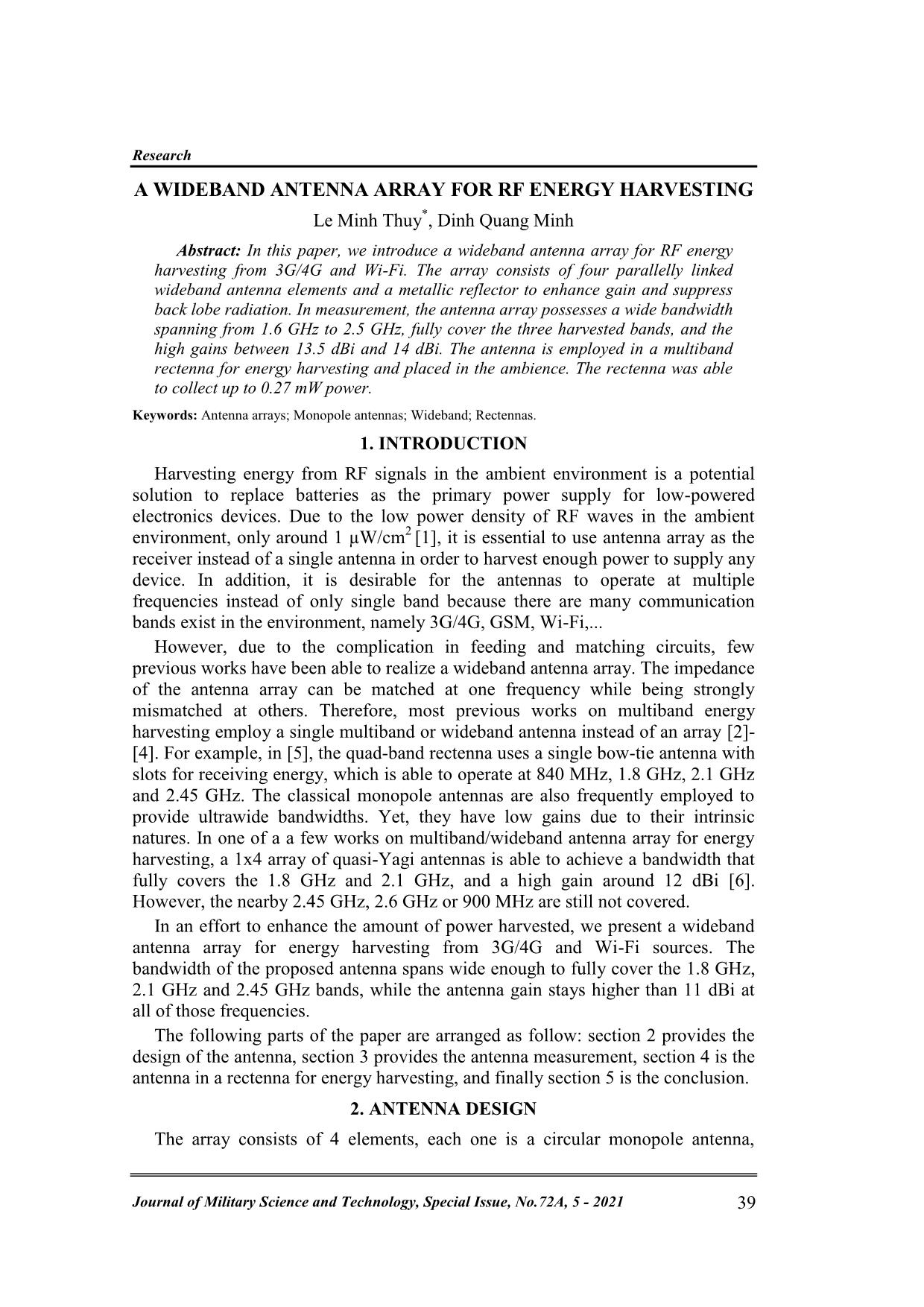
Trang 1
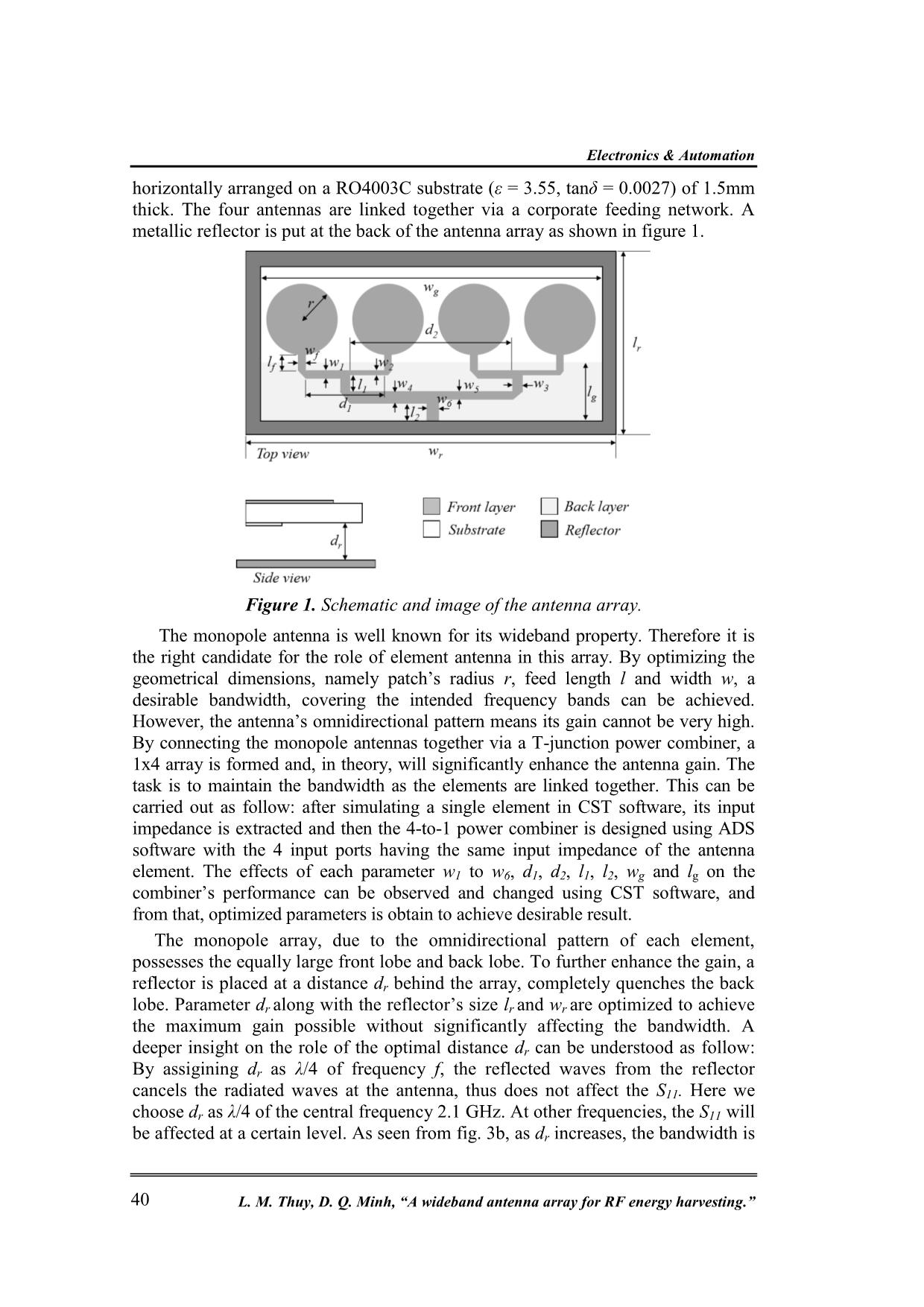
Trang 2
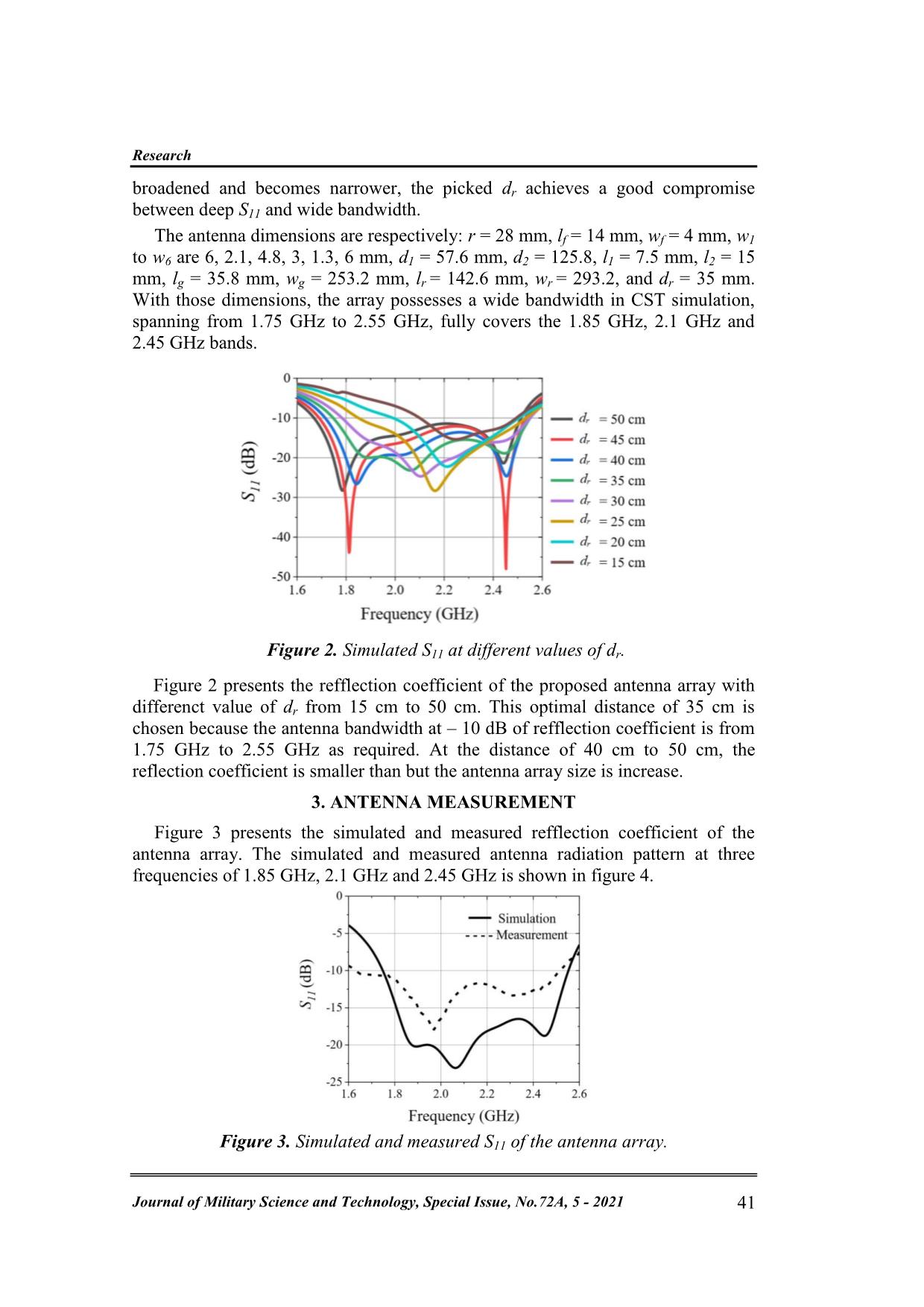
Trang 3
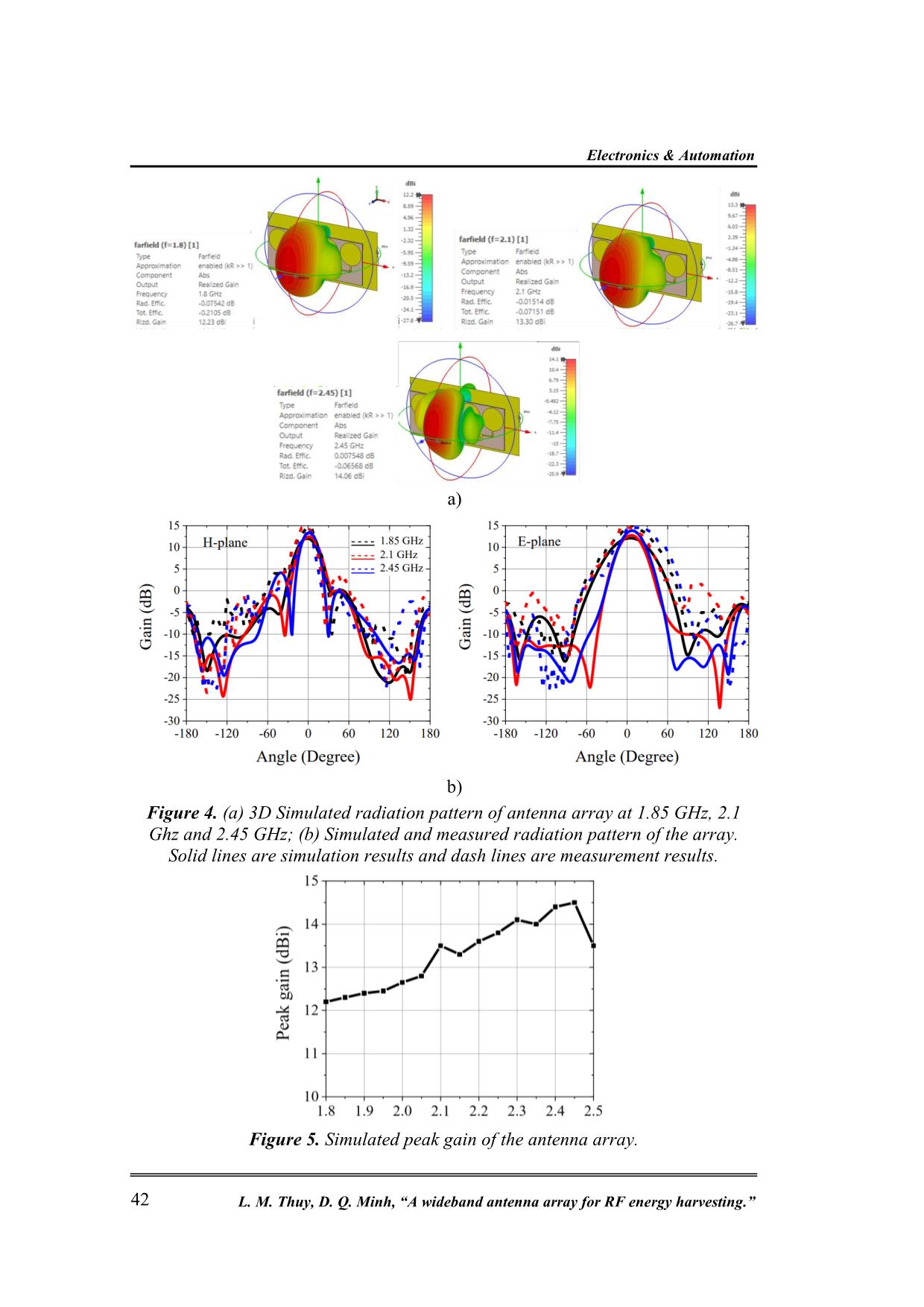
Trang 4
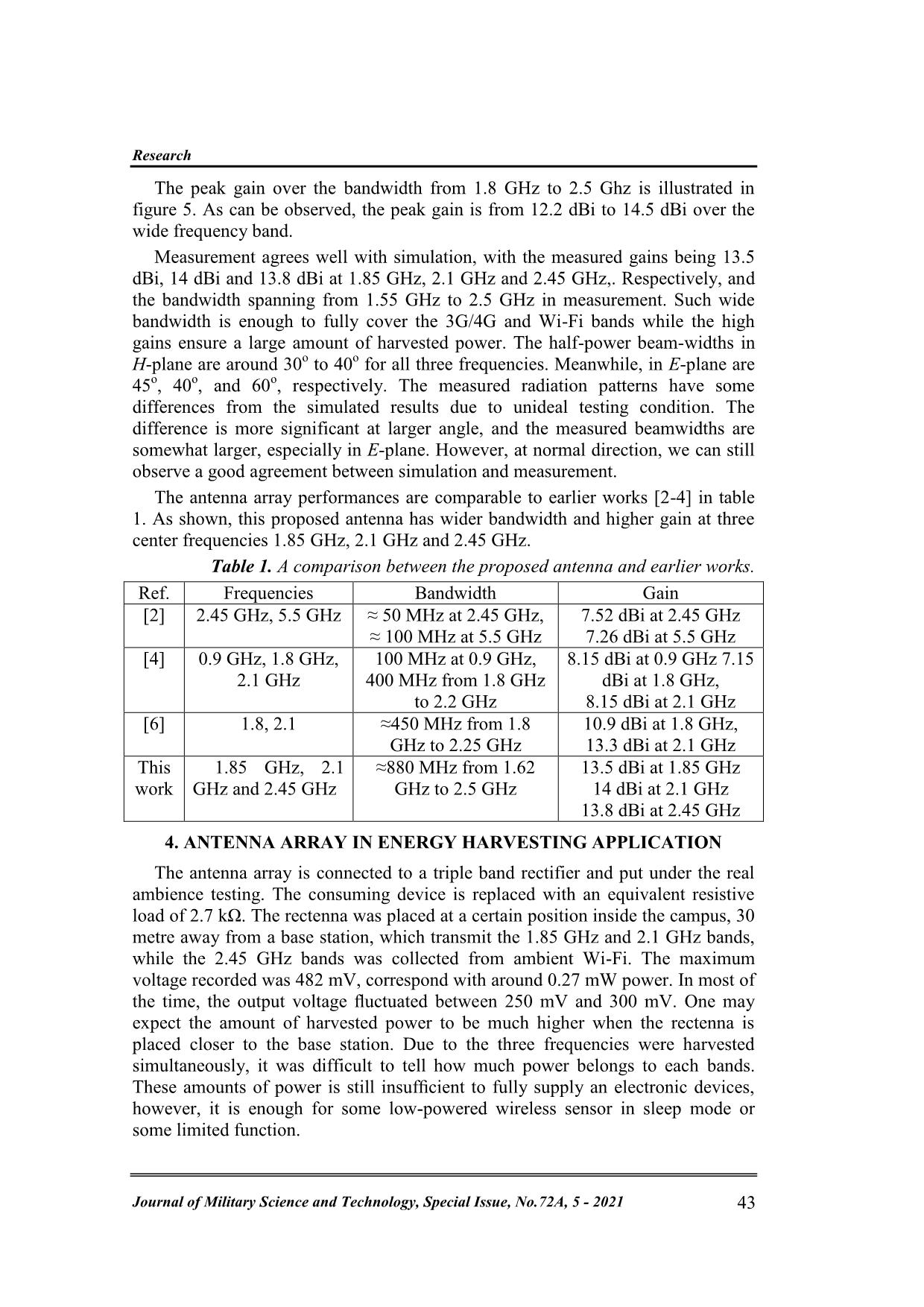
Trang 5
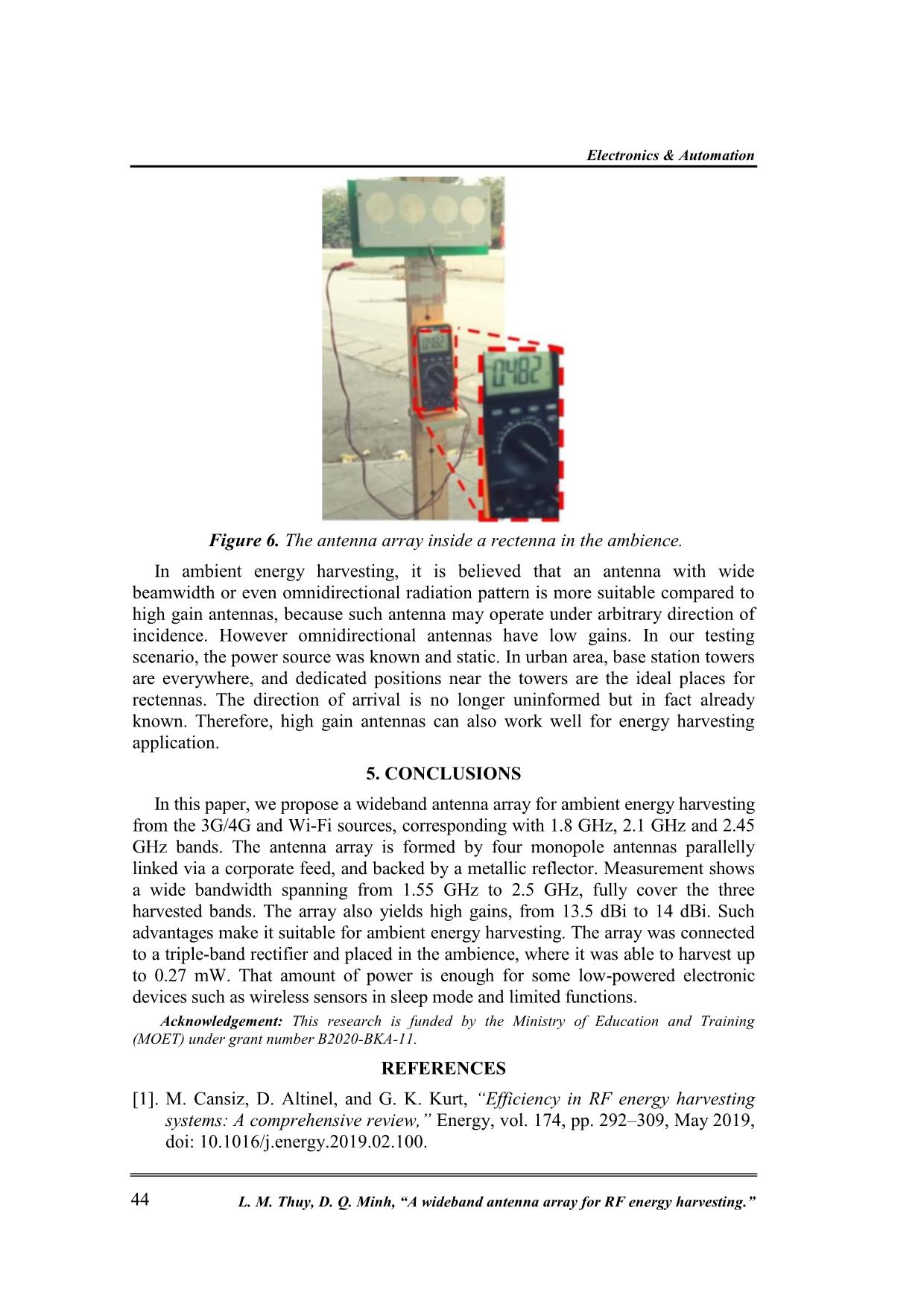
Trang 6
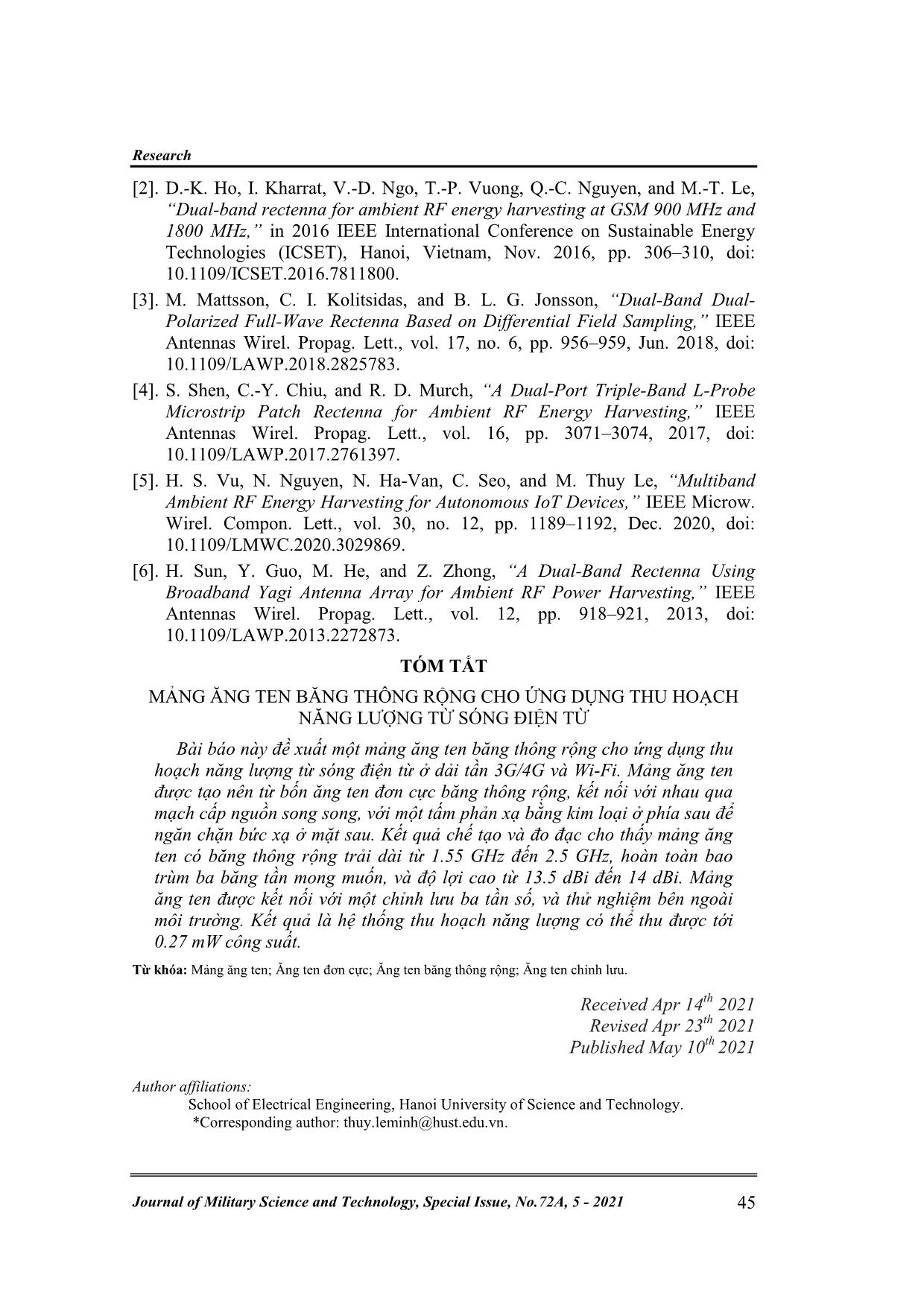
Trang 7
Bạn đang xem tài liệu "A wideband antenna array for RF energy harvesting", để tải tài liệu gốc về máy hãy click vào nút Download ở trên
Tóm tắt nội dung tài liệu: A wideband antenna array for RF energy harvesting
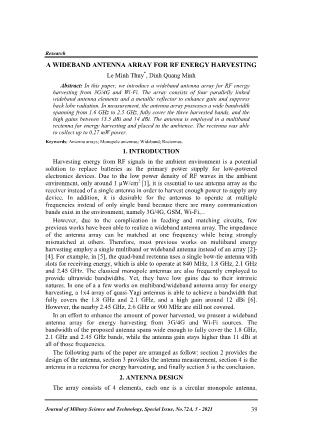
A WIDEBAND ANTENNA ARRAY FOR RF ENERGY HARVESTING Le Minh Thuy*, Dinh Quang Minh Abstract: In this paper, we introduce a wideband antenna array for RF energy harvesting from 3G/4G and Wi-Fi. The array consists of four parallelly linked wideband antenna elements and a metallic reflector to enhance gain and suppress back lobe radiation. In measurement, the antenna array possesses a wide bandwidth spanning from 1.6 GHz to 2.5 GHz, fully cover the three harvested bands, and the high gains between 13.5 dBi and 14 dBi. The antenna is employed in a multiband rectenna for energy harvesting and placed in the ambience. The rectenna was able to collect up to 0.27 mW power. Keywords: Antenna arrays; Monopole antennas; Wideband; Rectennas. 1. INTRODUCTION Harvesting energy from RF signals in the ambient environment is a potential solution to replace batteries as the primary power supply for low-powered electronics devices. Due to the low power density of RF waves in the ambient environment, only around 1 µW/cm2 [1], it is essential to use antenna array as the receiver instead of a single antenna in order to harvest enough power to supply any device. In addition, it is desirable for the antennas to operate at multiple frequencies instead of only single band because there are many communication bands exist in the environment, namely 3G/4G, GSM, Wi-Fi,... However, due to the complication in feeding and matching circuits, few previous works have been able to realize a wideband antenna array. The impedance of the antenna array can be matched at one frequency while being strongly mismatched at others. Therefore, most previous works on multiband energy harvesting employ a single multiband or wideband antenna instead of an array [2]- [4]. For example, in [5], the quad-band rectenna uses a single bow-tie antenna with slots for receiving energy, which is able to operate at 840 MHz, 1.8 GHz, 2.1 GHz and 2.45 GHz. The classical monopole antennas are also frequently employed to provide ultrawide bandwidths. Yet, they have low gains due to their intrinsic natures. In one of a a few works on multiband/wideband antenna array for energy harvesting, a 1x4 array of quasi-Yagi antennas is able to achieve a bandwidth that fully covers the 1.8 GHz and 2.1 GHz, and a high gain around 12 dBi [6]. However, the nearby 2.45 GHz, 2.6 GHz or 900 MHz are still not covered. In an effort to enhance the amount of power harvested, we present a wideband antenna array for energy harvesting from 3G/4G and Wi-Fi sources. The bandwidth of the proposed antenna spans wide enough to fully cover the 1.8 GHz, 2.1 GHz and 2.45 GHz bands, while the antenna gain stays higher than 11 dBi at all of those frequencies. The following parts of the paper are arranged as follow: section 2 provides the design of the antenna, section 3 provides the antenna measurement, section 4 is the antenna in a rectenna for energy harvesting, and finally section 5 is the conclusion. 2. ANTENNA DESIGN The array consists of 4 elements, each one is a circular monopole antenna, Journal of Military Science and Technology, Special Issue, No.72A, 5 - 2021 39 Electronics & Automation horizontally arranged on a RO4003C substrate (ε = 3.55, tanδ = 0.0027) of 1.5mm thick. The four antennas are linked together via a corporate feeding network. A metallic reflector is put at the back of the antenna array as shown in figure 1. Figure 1. Schematic and image of the antenna array. The monopole antenna is well known for its wideband property. Therefore it is the right candidate for the role of element antenna in this array. By optimizing the geometrical dimensions, namely patch’s radius r, feed length l and width w, a desirable bandwidth, covering the intended frequency bands can be achieved. However, the antenna’s omnidirectional pattern means its gain cannot be very high. By connecting the monopole antennas together via a T-junction power combiner, a 1x4 array is formed and, in theory, will significantly enhance the antenna gain. The task is to maintain the bandwidth as the elements are linked together. This can be carried out as follow: after simulating a single element in CST software, its input impedance is extracted and then the 4-to-1 power combiner is designed using ADS software with the 4 input ports having the same input impedance of the antenna element. The effects of each parameter w1 to w6, d1, d2, l1, l2, wg and lg on the combiner’s performance can be observed and changed using CST software, and from that, optimized parameters is obtain to achieve desirable result. The monopole array, due to the omnidirectional pattern of each element, possesses the equally large front lobe and back lobe. To further enhance the gain, a reflector is placed at a distance dr behind the array, completely quenches the back lobe. Parameter dr along with the reflector’s size lr and wr are optimized to achieve the maximum gain possible without significantly affecting the bandwidth. A deeper insight on the role of the optimal distance dr can be understood as follow: By assigining dr as λ/4 of frequency f, the reflected waves from the reflector cancels the radiated waves at the antenna, thus does not affect the S11. Here we choose dr as λ/4 of the central frequency 2.1 GHz. At other frequencies, the S11 will be affected at a certain level. As seen from fig. 3b, as dr increases, the bandwidth is 40 L. M. Thuy, D. Q. Minh, “A wideband antenna array for RF energy harvesting.” Research broadened and becomes narrower, the picked dr achieves a good compromise between deep S11 and wide bandwidth. The antenna dimensions are respectively: r = 28 mm, lf = 14 mm, wf = 4 mm, w1 to w6 are 6, 2.1, 4.8, 3, 1.3, 6 mm, d1 = 57.6 mm, d2 = 125.8, l1 = 7.5 mm, l2 = 15 mm, lg = 35.8 mm, wg = 253.2 mm, lr = 142.6 mm, wr = 293.2, and dr = 35 mm. With those dimensions, the array possesses a wide bandwidth in CST simulation, spanning from 1.75 GHz to 2.55 GHz, fully covers the 1.85 GHz, 2.1 GHz and 2.45 GHz bands. Figure 2. Simulated S11 at different values of dr. Figure 2 presents the refflection coefficient of the proposed antenna array with differenct value of dr from 15 cm to 50 cm. This optimal distance of 35 cm is chosen because the antenna bandwidth at – 10 dB of refflection coefficient is from 1.75 GHz to 2.55 GHz as required. At the distance of 40 cm to 50 cm, the reflection coefficient is smaller than but the antenna array size is increase. 3. ANTENNA MEASUREMENT Figure 3 presents the simulated and measured refflection coefficient of the antenna array. The simulated and measured antenna radiation pattern at three frequencies of 1.85 GHz, 2.1 GHz and 2.45 GHz is shown in figure 4. Figure 3. Simulated and measured S11 of the antenna array. Journal of Military Science and Technology, Special Issue, No.72A, 5 - 2021 41 Electronics & Automation a) b) Figure 4. (a) 3D Simulated radiation pattern of antenna array at 1.85 GHz, 2.1 Ghz and 2.45 GHz; (b) Simulated and measured radiation pattern of the array. Solid lines are simulation results and dash lines are measurement results. Figure 5. Simulated peak gain of the antenna array. 42 L. M. Thuy, D. Q. Minh, “A wideband antenna array for RF energy harvesting.” Research The peak gain over the bandwidth from 1.8 GHz to 2.5 Ghz is illustrated in figure 5. As can be observed, the peak gain is from 12.2 dBi to 14.5 dBi over the wide frequency band. Measurement agrees well with simulation, with the measured gains being 13.5 dBi, 14 dBi and 13.8 dBi at 1.85 GHz, 2.1 GHz and 2.45 GHz,. Respectively, and the bandwidth spanning from 1.55 GHz to 2.5 GHz in measurement. Such wide bandwidth is enough to fully cover the 3G/4G and Wi-Fi bands while the high gains ensure a large amount of harvested power. The half-power beam-widths in H-plane are around 30o to 40o for all three frequencies. Meanwhile, in E-plane are 45o, 40o, and 60o, respectively. The measured radiation patterns have some differences from the simulated results due to unideal testing condition. The difference is more significant at larger angle, and the measured beamwidths are somewhat larger, especially in E-plane. However, at normal direction, we can still observe a good agreement between simulation and measurement. The antenna array performances are comparable to earlier works [2-4] in table 1. As shown, this proposed antenna has wider bandwidth and higher gain at three center frequencies 1.85 GHz, 2.1 GHz and 2.45 GHz. Table 1. A comparison between the proposed antenna and earlier works. Ref. Frequencies Bandwidth Gain [2] 2.45 GHz, 5.5 GHz ≈ 50 MHz at 2.45 GHz, 7.52 dBi at 2.45 GHz ≈ 100 MHz at 5.5 GHz 7.26 dBi at 5.5 GHz [4] 0.9 GHz, 1.8 GHz, 100 MHz at 0.9 GHz, 8.15 dBi at 0.9 GHz 7.15 2.1 GHz 400 MHz from 1.8 GHz dBi at 1.8 GHz, to 2.2 GHz 8.15 dBi at 2.1 GHz [6] 1.8, 2.1 ≈450 MHz from 1.8 10.9 dBi at 1.8 GHz, GHz to 2.25 GHz 13.3 dBi at 2.1 GHz This 1.85 GHz, 2.1 ≈880 MHz from 1.62 13.5 dBi at 1.85 GHz work GHz and 2.45 GHz GHz to 2.5 GHz 14 dBi at 2.1 GHz 13.8 dBi at 2.45 GHz 4. ANTENNA ARRAY IN ENERGY HARVESTING APPLICATION The antenna array is connected to a triple band rectifier and put under the real ambience testing. The consuming device is replaced with an equivalent resistive load of 2.7 kΩ. The rectenna was placed at a certain position inside the campus, 30 metre away from a base station, which transmit the 1.85 GHz and 2.1 GHz bands, while the 2.45 GHz bands was collected from ambient Wi-Fi. The maximum voltage recorded was 482 mV, correspond with around 0.27 mW power. In most of the time, the output voltage fluctuated between 250 mV and 300 mV. One may expect the amount of harvested power to be much higher when the rectenna is placed closer to the base station. Due to the three frequencies were harvested simultaneously, it was difficult to tell how much power belongs to each bands. These amounts of power is still insufficient to fully supply an electronic devices, however, it is enough for some low-powered wireless sensor in sleep mode or some limited function. Journal of Military Science and Technology, Special Issue, No.72A, 5 - 2021 43 Electronics & Automation Figure 6. The antenna array inside a rectenna in the ambience. In ambient energy harvesting, it is believed that an antenna with wide beamwidth or even omnidirectional radiation pattern is more suitable compared to high gain antennas, because such antenna may operate under arbitrary direction of incidence. However omnidirectional antennas have low gains. In our testing scenario, the power source was known and static. In urban area, base station towers are everywhere, and dedicated positions near the towers are the ideal places for rectennas. The direction of arrival is no longer uninformed but in fact already known. Therefore, high gain antennas can also work well for energy harvesting application. 5. CONCLUSIONS In this paper, we propose a wideband antenna array for ambient energy harvesting from the 3G/4G and Wi-Fi sources, corresponding with 1.8 GHz, 2.1 GHz and 2.45 GHz bands. The antenna array is formed by four monopole antennas parallelly linked via a corporate feed, and backed by a metallic reflector. Measurement shows a wide bandwidth spanning from 1.55 GHz to 2.5 GHz, fully cover the three harvested bands. The array also yields high gains, from 13.5 dBi to 14 dBi. Such advantages make it suitable for ambient energy harvesting. The array was connected to a triple-band rectifier and placed in the ambience, where it was able to harvest up to 0.27 mW. That amount of power is enough for some low-powered electronic devices such as wireless sensors in sleep mode and limited functions. Acknowledgement: This research is funded by the Ministry of Education and Training (MOET) under grant number B2020-BKA-11. REFERENCES [1]. M. Cansiz, D. Altinel, and G. K. Kurt, “Efficiency in RF energy harvesting systems: A comprehensive review,” Energy, vol. 174, pp. 292–309, May 2019, doi: 10.1016/j.energy.2019.02.100. 44 L. M. Thuy, D. Q. Minh, “A wideband antenna array for RF energy harvesting.” Research [2]. D.-K. Ho, I. Kharrat, V.-D. Ngo, T.-P. Vuong, Q.-C. Nguyen, and M.-T. Le, “Dual-band rectenna for ambient RF energy harvesting at GSM 900 MHz and 1800 MHz,” in 2016 IEEE International Conference on Sustainable Energy Technologies (ICSET), Hanoi, Vietnam, Nov. 2016, pp. 306–310, doi: 10.1109/ICSET.2016.7811800. [3]. M. Mattsson, C. I. Kolitsidas, and B. L. G. Jonsson, “Dual-Band Dual- Polarized Full-Wave Rectenna Based on Differential Field Sampling,” IEEE Antennas Wirel. Propag. Lett., vol. 17, no. 6, pp. 956–959, Jun. 2018, doi: 10.1109/LAWP.2018.2825783. [4]. S. Shen, C.-Y. Chiu, and R. D. Murch, “A Dual-Port Triple-Band L-Probe Microstrip Patch Rectenna for Ambient RF Energy Harvesting,” IEEE Antennas Wirel. Propag. Lett., vol. 16, pp. 3071–3074, 2017, doi: 10.1109/LAWP.2017.2761397. [5]. H. S. Vu, N. Nguyen, N. Ha-Van, C. Seo, and M. Thuy Le, “Multiband Ambient RF Energy Harvesting for Autonomous IoT Devices,” IEEE Microw. Wirel. Compon. Lett., vol. 30, no. 12, pp. 1189–1192, Dec. 2020, doi: 10.1109/LMWC.2020.3029869. [6]. H. Sun, Y. Guo, M. He, and Z. Zhong, “A Dual-Band Rectenna Using Broadband Yagi Antenna Array for Ambient RF Power Harvesting,” IEEE Antennas Wirel. Propag. Lett., vol. 12, pp. 918–921, 2013, doi: 10.1109/LAWP.2013.2272873. TÓM TẮT MẢNG ĂNG TEN BĂNG THÔNG RỘNG CHO ỨNG DỤNG THU HOẠCH NĂNG LƯỢNG TỪ SÓNG ĐIỆN TỪ Bài báo này đề xuất một mảng ăng ten băng thông rộng cho ứng dụng thu hoạch năng lượng từ sóng điện từ ở dải tần 3G/4G và Wi-Fi. Mảng ăng ten được tạo nên từ bốn ăng ten đơn cực băng thông rộng, kết nối với nhau qua mạch cấp nguồn song song, với một tấm phản xạ bằng kim loại ở phía sau để ngăn chặn bức xạ ở mặt sau. Kết quả chế tạo và đo đạc cho thấy mảng ăng ten có băng thông rộng trải dài từ 1.55 GHz đến 2.5 GHz, hoàn toàn bao trùm ba băng tần mong muốn, và độ lợi cao từ 13.5 dBi đến 14 dBi. Mảng ăng ten được kết nối với một chỉnh lưu ba tần số, và thử nghiệm bên ngoài môi trường. Kết quả là hệ thống thu hoạch năng lượng có thể thu được tới 0.27 mW công suất. Từ khóa: Mảng ăng ten; Ăng ten đơn cực; Ăng ten băng thông rộng; Ăng ten chỉnh lưu. Received Apr 14th 2021 Revised Apr 23th 2021 Published May 10th 2021 Author affiliations: School of Electrical Engineering, Hanoi University of Science and Technology. *Corresponding author: thuy.leminh@hust.edu.vn. Journal of Military Science and Technology, Special Issue, No.72A, 5 - 2021 45
File đính kèm:
 a_wideband_antenna_array_for_rf_energy_harvesting.pdf
a_wideband_antenna_array_for_rf_energy_harvesting.pdf

